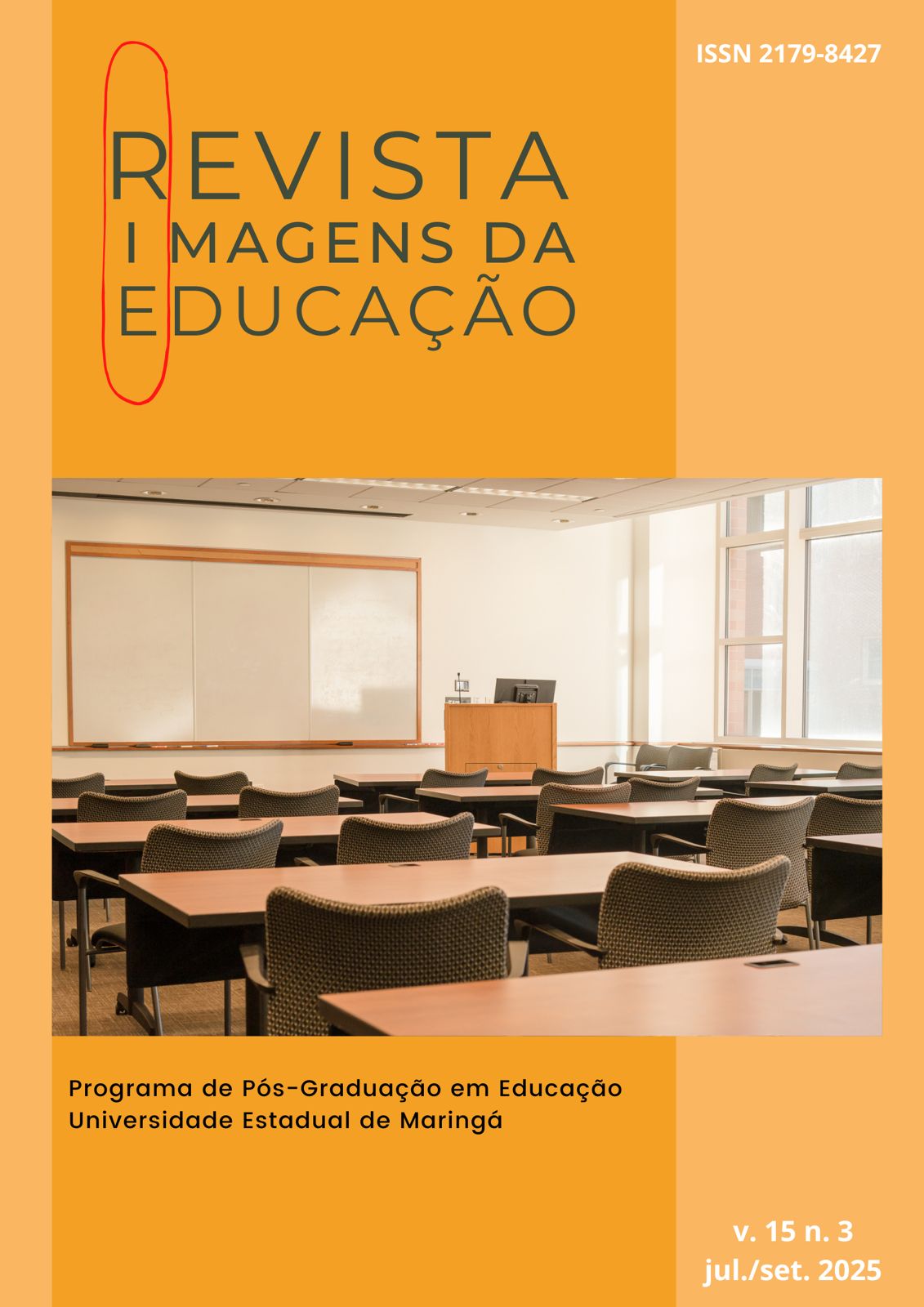USO DE TELAS NA INFÂNCIA
EXISTEM BENEFÍCIOS?
Resumo
Com a crescente integração das telas na vida das crianças, as atuais evidências têm enfatizado os prejuízos da exposição a telas durante a infância. Este trabalho trata-se de uma revisão integrativa que visa fornecer uma síntese dos estudos que abordam os potenciais benefícios da utilização de telas para a faixa etária entre 2 e 10 anos e como promover o uso mais saudável. As pesquisas foram realizadas em março de 2023 nas bases de dados eletrônicas Embase, BVS e PubMed. Foram encontrados benefícios no desenvolvimento cognitivo, na saúde física e bem-estar, no desenvolvimento socioemocional e na linguagem e comunicação das crianças. Esses resultados positivos estavam associados ao monitoramento parental, à covisualização, à limitação da duração do tempo de tela e à restrição do tipo de conteúdo, revelando o papel de influência dos pais e cuidadores no uso de telas das crianças.
Downloads
Referências
Canadian Paediatric Society. (2017). Screen time and young children: Promoting health and development in a digital world. Paediatrics & Child Health, 22(8), 461–468.
Cao, S., & Li, H. (2023). A scoping review of digital well-being in early childhood: Definitions, measurements, contributors, and interventions. International Journal of Environmental Research and Public Health, 20(4), 3510.
Cerniglia, L., & Cimino, S. (2020). A reflection on controversial literature on screen time and educational apps use in 0–5 years old children. International Journal of Environmental Research and Public Health, 17(13), 4641.
Chassiakos, Y. R., et al. (2016). Children and adolescents and digital media. Pediatrics, 138(5).
Chong, S. C., et al. (2023). Exploring the perception of parents on children’s screentime: A systematic review and meta-synthesis of qualitative studies. Pediatric Research, 1–11.
Fang, K., Mu, M., Liu, K., & He, Y. (2019). Screen time and childhood overweight/obesity: A systematic review and meta-analysis. Child: Care, Health and Development, 45(5), 744–753.
Felix, E., Silva, V., Caetano, M., Ribeiro, M. V. V., Fidalgo, T. M., & Rosa Neto, F. (2020). Excessive screen media use in preschoolers is associated with poor motor skills. Cyberpsychology, Behavior, and Social Networking, 23(6), 418–425.
Ferreira, J., et al. (2020). Screen time use in children less than five years old. Nascer e Crescer, 29(4), 188–195.
Guedes, S. da C., et al. (2019). Children’s use of interactive media in early childhood - An epidemiological study. Revista Paulista de Pediatria, 38.
Guerrero, M. D., Barnes, J. D., Chaput, J. P., & Tremblay, M. S. (2019). Screen time and problem behaviors in children: Exploring the mediating role of sleep duration. International Journal of Behavioral Nutrition and Physical Activity, 16(1).
Karani, N. F., Sher, J., & Mophosho, M. (2022). The influence of screen time on children’s language development: A scoping review. South African Journal of Communication Disorders, 69(1), 7.
Kerai, S., et al. (2022). Screen time and developmental health: Results from an early childhood study in Canada. BMC Public Health, 22(1). https://doi.org/10.1186/s12889-022-12787-6
López-Gil, J. F., Oriol-Granado, X., Izquierdo, M., Ramírez-Vélez, R., Fernández-Vergara, O., Olloquequi, J., et al. (2020). Healthy lifestyle behaviors and their association with self-regulation in Chilean children. International Journal of Environmental Research and Public Health, 17(16), 5676.
Madigan, S., McArthur, B. A., Anhorn, C., Eirich, R., & Christakis, D. A. (2020). Associations between screen use and child language skills. JAMA Pediatrics, 174(7).
Madigan, S., et al. (2019). Association between screen time and children’s performance on a developmental screening test. JAMA Pediatrics, 173(3). https://doi.org/10.1001/jamapediatrics.2018.5056
Miguel-Berges, M. L., De Miguel-Etayo, P., Larruy-García, A., Jimeno-Martinez, A., Pellicer, C., & Moreno Aznar, L. (2022). Lifestyle risk factors for overweight/obesity in Spanish children. Children, 9(12), 1947.
Morawska, A., Mitchell, A. E., & Tooth, L. R. (2023). Managing screen use in the under-fives: Recommendations for parenting intervention development. Clinical Child and Family Psychology Review, 1–14.
Nagata, J. M., Iyer, P., Chu, J., Baker, F. C., Gabriel, K. P., & Garber, A. K., et al. (2021). Contemporary screen time usage among children 9–10 years old is associated with higher body mass index percentile at 1-year follow-up: A prospective cohort study. Pediatric Obesity, 16(12).
Nobre, J. N. P., et al. (2021). Fatores determinantes no tempo de tela de crianças na primeira infância. Ciência & Saúde Coletiva, 26(3), 1127–1136.
Nobre, J. N. P., et al. (2019). Quality of interactive media use in early childhood and child development: A multicriteria analysis. Jornal de Pediatria, 96(3).
Oflu, A., Tezol, O., Yalcin, S., Yildiz, D., Caylan, N., & Ozdemir, D. F., et al. (2021). El uso excesivo de pantallas está asociado con labilidad emocional en niños preescolares. Arch Argent Pediatr, 119(2), 106–113.
Oppici, L., et al. (2022). A skill acquisition perspective on the impact of exergaming technology on foundational movement skill development in children 3–12 years: A systematic review and meta-analysis. Sports Medicine - Open, 8(1).
Puzio, D., Makowska, I., & Rymarczyk, K. (2022). Raising the child—Do screen media help or hinder? The quality over quantity hypothesis. International Journal of Environmental Research and Public Health, 19(16), 9880.
Rideout, V., & Robb, M. B. (2020). The common sense census: Media use by kids age zero to eight. San Francisco, CA: Common Sense Media.
Rocha, B., & Nunes, C. (2020). Benefits and damages of the use of touchscreen devices for the development and behavior of children under 5 years old—a systematic review. Psicologia: Reflexão e Crítica, 33(1).
Rocha, H. A. L., et al. (2021). Screen time and early childhood development in Ceará, Brazil: A population-based study. BMC Public Health, 21(1).
Santos, R. M. S., Mendes, C. G., Marques, M. I. R., & Romano-Silva, M. A. (2022). The association between screen time and attention in children: A systematic review. Developmental Neuropsychology, 47(4), 1–18.
Schwarzer, C., et al. (2021). Associations of media use and early childhood development: Cross-sectional findings from the LIFE Child study. Pediatric Research, 91(1), 247–253.
Sociedade Brasileira de Pediatria. (2019). Manual de orientação: #Menos telas #Mais saúde.
Stiglic, N., & Viner, R. M. (2019). Effects of screentime on the health and well-being of children and adolescents: A systematic review of reviews. BMJ Open, 9(1).
Straker, L., et al. (2018). Conflicting guidelines on young children’s screen time and use of digital technology create policy and practice dilemmas. The Journal of Pediatrics, 202, 300–303.
Tomaz, S. A., Hinkley, T., Jones, R. A., Watson, E. D., Twine, R., & Kahn, K., et al. (2020). Screen time and sleep of rural and urban South African preschool children. International Journal of Environmental Research and Public Health, 17(15), 5449.
Varadarajan, S., et al. (2021). Prevalence of excessive screen time and its association with developmental delay in children aged <5 years: A population-based cross-sectional study in India. PLOS ONE, 16(7). https://doi.org/10.1371/journal.pone.0254102
World Health Organization. (2019). Guidelines on physical activity, sedentary behaviour and sleep for children under 5 years of age. World Health Organization.
Xiang, H., et al. (2022). Associations of excessive screen time and early screen exposure with health-related quality of life and behavioral problems among children attending preschools. BMC Public Health, 22(1). https://doi.org/10.1186/s12889-021-12490-7
Copyright (c) 2025 Imagens da Educação

This work is licensed under a Creative Commons Attribution-NonCommercial-NoDerivatives 4.0 International License.
Declaro que o presente artigo é original, não tendo sido submetido à publicação em qualquer outro periódico nacional ou internacional, quer seja em parte ou em sua totalidade. Declaro, ainda, que uma vez publicado na revista Imagens da Educação,ele não será submetido por mim ou pelos demais co-autores a outro periódico. Por meio deste instrumento, em meu nome e dos co-autores, cedo os direitos autorais do referido artigo à Revista e declaro estar ciente de que a não observância deste compromisso submeterá o infrator a sanções e penas previstas na Lei de Proteção de Direitos Autorias (Nº 9609, de 19/02/98).















1.png)

